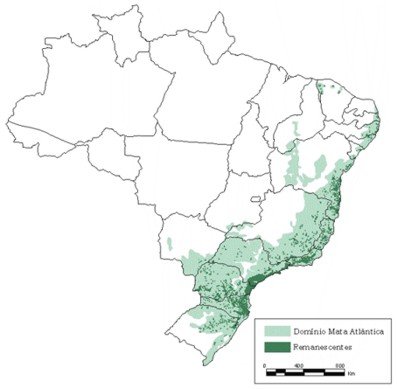Agroforestry: A New Restoration Horizon for Brazil's Most Degraded Forest Biome
Cacao Cabruca Production in Terra Vista. (Carlos Alberto)
Restoring the Atlantic Forest is one of the greatest environmental challenges in Brazil. Whilst the Amazon Forest, located Northwest, makes the news as Brazil's threatened biome, several other areas also suffer from the impacts of clear-cutting.
The forest that once stretched over most of Brazil's coast to the east is now composed of small and degraded forest patches that account for merely 7% of its original cover. Deforestation promoted by Portuguese extraction during the colonial period was perpetuated through rapid urban and agricultural advancement in the coast. According to the Brazilian Institute of Geography and Statistics, approximately 72% of Brazil's population lived in the area as of 2014.
Map indicates in light green original Atlantic Forest cover; dark green coveys reminiscent areas today. (Reserva da Biosfera da Mata Atlântica)
In biomes hurt by urban sprawl and agricultural advancement, understanding the potential of solutions that integrate human and agricultural systems will help bridge the well-being of the population and the environment. That is why agroforestry has attracted the attention of farmers, researchers and policy makers in the last decade as a new horizon for forest conservation in tropical regions like the Atlantic biome.
Bridging forest and sustainable agriculture
Agroforestry integrates tree and agricultural ecosystems as a way to increase biodiversity, enhance soil fertility over time, and protect forest coverage. It also harnesses social co-benefits, such as increased food security, climate adaptation and income diversification. Globally, efforts to implement and research agroforestry systems are on the rise: the Global Agroforestry Network and Center for International Forestry Research are two examples of transnational initiatives. On the ground, networks like the Vale do Paraíba advance cooperation and knowledge exchange between hundreds of agroforestry farmers.
Through promotion of a sustainable and people-focused approach, agroforestry contrasts sharply with the agribusiness model that was responsible for 97% of deforestation in Brazil in 2021 alone. It emerges as an important method to break the dichotomy between forest preservation and agriculture, providing opportunity for ecological recovery and human well-being in degraded forest landscapes.
An article published in the People and Nature magazine in 2022 assessed family farms in São Paulo and found that farmers observations corroborate with scientific literature in reporting higher yields, decreased temperature on the farm and increased food security in agroforestry systems. Since 2012, Brazilian law has recognized agroforestry's benefits in legal terms. The Brazil's Native Vegetation Protection Law (Law No. 12,651; 2012) forecasts in Chapter X incentives for practices and technologies that "reconcile agricultural and forestry productivity, with reduction of environmental impacts, as a way of promoting ecologically sustainable development", making agroforestry an acceptable method of restoration.
Eleven years later, however, agroforestry remains largely absent from regional and national restoration plans and continues to be overlooked in agricultural policy.
A practice embraced by popular movements and NGOs
That does not mean agroforestry practice is disregarded by farmers and the non-governmental community. In 2017, small holders from the Landless Workers Movement launched a campaign to restore 400,000 hectares of Atlantic Forest through Cocoa Cabruca agroforestry in southern Bahia. In 2021, the documentary "Cocoa and Freedom," directed by Felipe Abreu and Patricia Moll, documented the power of ecological agroforestry production in reclaiming sovereignty for the farmer community long marginalized by exploitative labor systems. The workers are now involved with pesticide-free cocoa production that preserves Atlantic forest cover, fostering a more ethical production cycle and honoring local biodiversity and produce.
SiAMA, a non-governmental body that uses agroforestry as a regional development strategy, has been training farmers, elaborating market strategies and mobilizing agricultural networks in the Atlantic region. In 2022, they published a Report on Agroforestry Experiences in Brazil that details challenges and accomplishments of agroforestry projects. Their efforts culminated in an interactive map that gathers information about hundreds of agroforestry farms across the biome, which helps situate and document the advancement of such projects in the region.
The future of agroforestry
Nevertheless, these efforts alone cannot guarantee a sustained and coordinated restoration approach. Heavy funding for agribusiness over small-scale farming is a factor hindering the success of sustainable agriculture in Brazil. Without adequate financial support, technical knowledge and governmental policies, severe challenges will remain for farms' transition to agroforestry systems and distribution of agroforestry produce.
The lack of focus on the role of people in environmental conservation is another barrier. Brazil's biggest urban centers are located in the area, and agroforestry can be a powerful tool to help citizens interact and understand the importance of forests for cities, ecosystems services such as clean air, water purification, and food. For that to happen, the government will have to step in with incentives for accessible agroforestry produce and environmental education opportunities.
During the presidency of Jair Bolsonaro (2019-2022), small farmers and issues of food security were severely overlooked, and his discourse discredited important, popular agrarian movements like the Landless Workers. As new president Luiz Inácio Lula da Silva begins his term in office following the November 2022 elections, the expectations are that governmental policy will shift toward favoring sustainable and small-scale farming, as well as forest conservation, which indicate a positive scenario for the future of agroforestry as a restoration method. This is an opportunity for Brazil, as a biodiversity hotspot and an agricultural country, to demonstrate leadership in ecological transition and social development of rural communities, starting from its most degraded biome in the populous coast.


